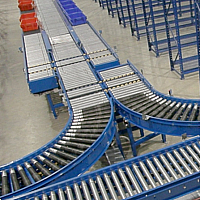Double your Production Capacity and minimise Manual Handling Costs
It is becoming expected in today’s business environment that menial day-to-day tasks right through to production systems and processes should be sped up at such a velocity in order to keep up with technological trends and societal expectations.
With amazing technological capabilities being produced worldwide across all industries, consumers are being faced with more choice than ever before. As a result; Time becomes a critical selection criterion that is ingrained in the standard consumer way of thinking. Businesses must adjust to meet these expectations and it is the Warehouse Manager who is often faced with the dilemma of how to process the order requirements in ever shortening production allowance times.
This dilemma boils down to the balancing act between the two mindsets; Customers demanding short supply times which is the mindset of “we want to order today and we want it delivered tomorrow!”. All the while, management and stakeholders are wanting/needing growth.
The ability to “push” more and more product out the door is essential to achieve ever increasing production and sales targets and therefore allowing the business to “pull” in more business opportunities and grow.
It’s a problem that virtually every sales driven company must face from time to time and often solutions put into play do not achieve the desired outcome.
In a typical warehouse operation where orders are being picked / packed the typical solution is often to throw more labour at the problem or to work longer hours to process the orders.
In doing this, the warehouse manager increases the up-front “cost per parcel” through labour costs spiralling upwards and inevitably the business reaches maximum operator limitations.
While this solution is not sustainable the solution lies in the problem; production efficiencies will become greatly reduced as the order processors spend more and more time undertaking unproductive travel through the warehouse. It follows that streamlining time-heavy components of the process such as this is one will allow for major production efficiencies and therefore capabilities.
Inevitably the warehouse manager or business will contemplate a move towards automated handling and the associated benefits provided by this. Quite typically an automated conveyor system specifically designed for production efficiency once implemented within a warehouse in order to meet customer requirements, can and will deliver rapid and startling results.
The benefits of such a move can return the following benefits which cannot be underestimated:-
- Better than 50% reduction in labour costs to process the same number of orders.
- Alternatively, better than 100% increase in the number of orders processed using the same number of staff and sometimes less.
- Significant “cost per parcel” reductions to process higher volumes of orders.
- Personnel travelling times throughout the warehouse is markedly reduced.
- Provides reduced incidence of recorded errors in order processing.
- Minimises the potential of OH&S incidents as operators do less manual tasks.
- Offers a win-win-win scenario for business owners, managers and customers with regard to time.
- Can often provide more accurate order tracking and feedback.
- Offers capabilities to “cross dock” orders from receivables to dispatch for “back orders” or “urgent orders” on the same day that they are received into the warehouse - a major advantage given the above mentioned adjustment in consumers’ expectation of time.
Elements of the above can often be achieved even in the simplest automated system designs without the need for massive capital expenditure that would be associated with more sophisticated hardware and controls.
What’s more is that today’s system hardware offers excellent “scope” to upgrade from a basic system design through numerous growth stages within the company as it grows. This means that nowadays you can start your business off with a basic system and build it up as your business grows.
As we experience a country wide change in the manufacturing industries with more and more warehouses or distribution centres being established here in Australia, it is evident that growing companies must adapt to, and embrace automated handling methods.
Continuing with “manual handling”, i.e. to stay the same, is not a sustainable production method to continue to provide a level of service that consumers are demanding! And even more pertinent is that “manual handling” certainly cannot support or provide growth!
If you are contemplating automated handling, talk to Adept. We manufacture high quality conveyor systems, in Australia, for a broad range of industries. We have enormous depth of experience and will help you with any materials handling project, at every step of the way.
DATE: JULY 10, 2014

